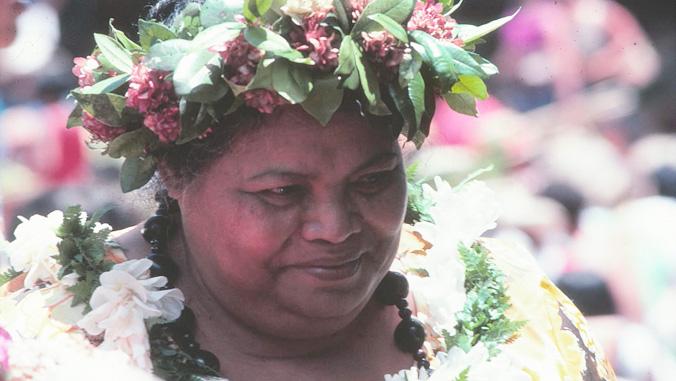Edith Kanakaʻole commemorative U.S. quarter hits circulation

A commemorative U.S. quarter honoring a Hawaiian cultural icon was released into circulation by the U.S. Mint today.
The image of the late kumu hula Edith Kanakaʻole is printed on the backside of the 25-cent piece as part of a 2023 commemorative series for the American Women Quarters Program by the U.S. Mint. Kanakaʻole is described as a key influence in the Hawaiian renaissance of the 1970s as she worked to preserve the Hawaiian culture and language.
The award-winning composer, who taught at Hawaiʻi Community College (1971 to 1974) and the University of Hawaiʻi at Hilo (1974 to 1979), Kanakaʻole created courses and seminars on subjects including Hawaiian language, ethnobotany, Polynesian history, genealogy and Hawaiian chant and mythology.
“It was a joy to become aware of Edith Kanakaʻole’s legacy as I developed a design for her quarter,” said Artistic Infusion Program Designer Emily Damstra. “I came to understand that her deep connection to the land—her home in Hawaiʻi near the Mauna Kea volcano—played a large role in her life and work. To best honor the various ways she made an impact, I felt that the design should emphasize her relationship to that environment.”

The coin depicts a portrait of Kanakaʻole, with her hair and lei poʻo (head lei) morphing into the elements of a Hawaiian landscape, symbolizing Kanakaʻole’s life’s work of preserving the natural land and traditional Hawaiian culture. The inscription “E hō mai ka ʻike” translates as “granting the wisdom,” and is a reference to the intertwined role hula and chants play in this preservation.
The other side of the coin depicts a portrait of George Washington, originally designed and sculpted by Laura Gardin Fraser to mark his 200th birthday in 1932.
Edith Kekuhikuhipuʻuone o nā aliʻi o Kohala Kanakaʻole (1913-1979), known as Auntie Edith, was a kumu hula as well as an educator. Through hula, a dance to pass down knowledge to the next generations, and moʻolelo (stories), Kanakaʻole helped to preserve aspects of Hawaiian knowledge, history, culture and traditions that were disappearing due to the cultural bigotry of the time, according to a press release from the University of Hawai‘i.
She preserved the ancient style of hula accompanied by rhythmic instruments done in the style she passed on which is identified as ʻaihaʻa, or low to the ground. Kanakaʻole was a kumu hula, a master instructor for hula, and an academic researcher who developed her own chants for cultural preservation and academic work.
Kanakaʻole’s contributions extend to the work of environmental scientists, and universities that teach her philosophies and scientific methods, and position Hawaiʻi and the U.S. in the global conversation on climate resilience.

The Edith Kanakaʻole Foundation, a Hawaiian cultural-based nonprofit organization established in 1990, helps maintain and perpetuate her teachings, beliefs, practices, philosophies and traditions. A celebration of Kanakaʻole’s contributions and legacy will be held at UH Hilo on May 6.
American Women Quarters will also feature First Lady and first chair of the U.N. Commission on Human Rights Eleanor Roosevelt, first African American and first Native American woman pilot Bessie Coleman, Mexican American journalist Jovita Idár and Maria Tallchief a Native American and America’s first major prima ballerina.







